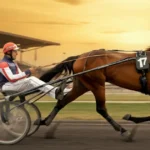Horse racing enthusiasts are no strangers to the variety of track surfaces that influence the performance of horses. Among these, barthturf stands out as a unique and significant surface that has shaped aspects of the sport for years. Whether you’re a fan, a bettor, or part of the racing community, understanding barthturf can provide fascinating insights into how environment and surface affect horse racing outcomes.
This blog dives into barthturf’s historical relevance, its unique properties, and its impact on the racing world. From iconic events held on barthturf tracks to expert tips for training racehorses on this surface, we’ll explore why it’s a topic of growing interest among the horse racing community.
A Glimpse at Barthturf in Horse Racing
Barthturf is a specialized racing surface often preferred for its natural composition that blends durability and performance. Unlike synthetic or traditional dirt tracks, barthturf offers a middle ground that combines stability with the ability to adapt to varying climates.
Its significance in horse racing lies in the way it interacts with the animals. The surface is designed to provide optimal footing while minimizing stress on horses’ legs. This makes it a valuable choice for both short and medium-length races, and appeals to trainers and jockeys committed to their horses’ long-term health.
The Evolution of Barthturf
The use of barthturf in horse racing has a rich history. Originally developed to address the limitations of dirt and grass tracks, barthturf was introduced as an alternative that promised better water drainage, reduced injury risks, and more uniform performance conditions.
Early iterations of barthturf were relatively simple combinations of soil and turf grass, but over time, improvements in material science allowed for better formulations. Today’s barthturf includes engineered blends tailored to specific racing needs, making it a go-to choice for tracks in regions with extreme weather conditions or heavy rainfall.
Its evolution has been influenced by industry leaders and research teams working to optimize the balance between performance and safety. Technological advancements now enable precise turf management, ensuring consistent quality from one race to the next.
Unique Characteristics and Challenges of Barthturf
Key Features of Barthturf
Barthturf is celebrated for its ability to offer the best of both dirt and grass tracks. Key characteristics include:
- Superior Drainage: Designed to eliminate surface water quickly, barthturf remains usable even after heavy rain, preventing cancellations or delays.
- Consistency: Unlike traditional dirt, which can harden over time, barthturf retains its texture across racing seasons.
- Low Impact: The surface minimizes shock absorption, ideal for longer races or those involving younger horses.
Challenges of Barthturf
However, racing on barthturf isn’t without its challenges. Horses often require tailored training routines to adapt to the surface. For jockeys, barthturf presents a learning curve as it impacts race dynamics, such as braking and acceleration, differently than traditional dirt or turf tracks. Additionally, maintaining the quality of barthturf requires specialized care, making it more expensive to manage over time.
Iconic Races Held on Barthturf
Over the years, barthturf has hosted numerous prestigious events, further increasing its prominence in the horse racing arena. Some of the most memorable races held on barthturf include:
- The Southern Invitation Stakes in Kentucky, which showcases top-tier competitors on pristine barthturf tracks.
- The Monarch’s Cup, celebrated for its challenging conditions that test both racing teams and their equipment.
- Summer Gallop Stakes in California, a tour de force among mid-length races that highlight barthturf’s adaptive capabilities.
Events like these draw attention not only to racing talent but also to the surface, elevating barthturf in horse racing culture.
Expert Training Tips for Racing on Barthturf
Racing on barthturf requires horses, trainers, and jockeys to adapt their strategies. Here are some expert tips to optimize performance on this unique surface:
- Gradual Adaptation
Horses new to barthturf need time to adjust. Incorporate light jogging sessions on the surface before increasing intensity to ensure they build confidence.
- Focus on Balance
Barthturf has a softer give than dirt, so maintaining balance becomes critical. Work with experienced jockeys who can read the surface and adjust stride patterns accordingly.
- Specialized Shoes
Barthturf-specific horseshoes can enhance a horse’s grip, providing better handling and performance. Consult farriers familiar with the demands of the surface for the best results.
- Monitor Recovery
Track recovery times post-race, as barthturf’s unique characteristics can affect horses differently compared to other surfaces. Proper rest and hydration are essential to maintain peak performance.
The Future of Barthturf in Horse Racing
Looking ahead, barthturf’s role in the world of horse racing is likely to expand. The growing emphasis on horse safety and the environmental sustainability of racing venues positions barthturf as a promising solution. Not only does it reduce the risk of career-ending injuries for horses, but advanced technology behind its construction also makes it more eco-friendly than many traditional track surfaces.
Innovation in barthturf will include improved durability, potentially minimizing costs and increasing its accessibility for smaller racing venues. Futuristic AI turf management systems may also emerge, allowing venues to monitor and maintain barthturf conditions in real-time.
Its adoption could signify a shift in global horse racing standards, bringing a new era of heightened precision and fairness to one of the world’s oldest sports.
Why Barthturf Matters
Barthturf is far more than a racing surface. It reflects the evolution of horse racing as a disciplined sport that combines tradition with technology. By prioritizing safety, performance, and sustainability, it sets a high standard for track surfaces moving forward.
For enthusiasts, bettors, and industry professionals alike, understanding the nuances of barthturf opens up new dimensions to appreciate and engage with the sport of horse racing.
Keep an eye on barthturf tracks near you for some of the most exciting advancements and races in modern horse racing.







